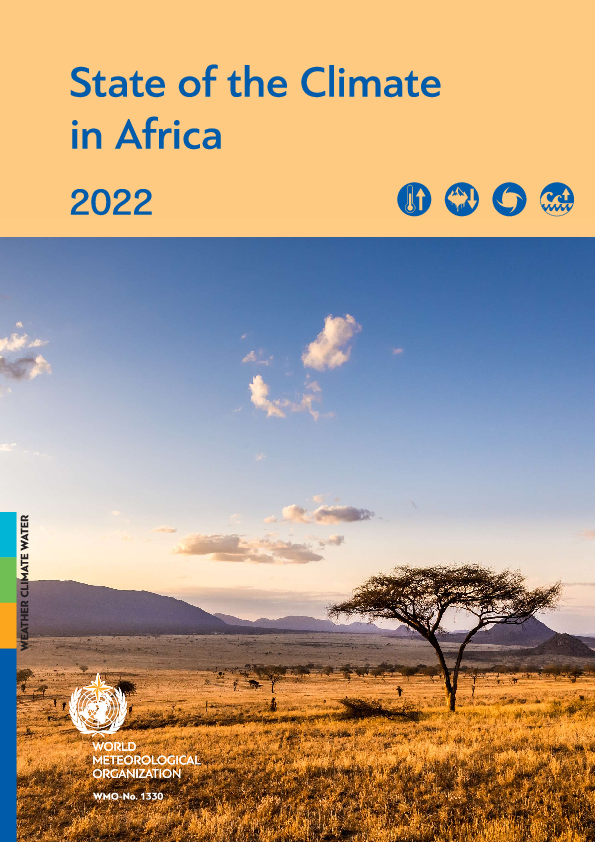- Share this article
- Subscribe to our newsletter
The State of the Climate in Africa 2022
More than 110 million people on the African continent were directly affected by weather-, climate- and water-related hazards in 2022, causing more than USD 8.5 billion in economic damage. This was stated in The State of the Climate in Africa 2022 report released by the World Meteorological Organization (WMO) at the Africa Climate Summit in September 2023. The report was produced jointly with the African Union Commission and Africa Climate Policy Centre of the United Nations Economic Commission for Africa (UNECA).
There were a reported 5000 fatalities, of which 48 per cent were associated with drought and 43 per cent were associated with flooding, according to the Emergency Event Database. But the true toll is likely to be much higher because of under-reporting.
Agriculture is the mainstay of Africa’s livelihoods and national economies – supporting more than 55 per cent of the labour force. But its agricultural productivity growth has declined by 34 per cent since 1961 due to climate change. This is the highest decline of any region in the world. Projected annual food imports by African countries are expected to increase by a factor of about three, from USD 35 billion to USD 110 billion by 2025.
The level of loss and damage, and therefore the costs incurred, will depend on many factors, including the level of ambition of global mitigation actions and the level of investment in adaptation at the local level. In a 4 °C warming world, with strong regional adaptation, “residual damages” costs equivalent to 3 per cent of Africa’s projected gross domestic product could be incurred annually by 2080.
The loss and damage costs in Africa due to climate change are projected to range between USD 290 billion and USD 440 billion, depending on the degree of warming, according to UNECA’s African Climate Policy Centre.
Climate change and the diminishing natural resource base could fuel conflicts over scarce productive land, water, and pastures, where farmer-herder violence has increased over the past 10 years due to growing land pressure, according to the report. This is concentrated in sub-Saharan countries.
Key messages
Temperature: The average rate of warming in Africa was +0.3 °C/decade during the 1991–2022 period, compared to +0.2 °C/decade between 1961 and 1990. This is slightly above the global average. The warming has been most rapid in North Africa, which was gripped by extreme heat, fuelling wildfires in Algeria and Tunisia, in 2022.
Rainfall: The Horn of Africa faced its worst drought in 40 years, with Ethiopia, Kenya and Somalia particularly hard hit. The “triple-dip” La Niña was a substantial contributor. Five consecutive failed rainfall seasons reduced agricultural productivity and food security.
Many parts of the Sahel experienced significant flooding during the monsoon season, with Nigeria, Niger, Chad and the southern half of Sudan particularly affected.
Tropical Cyclones: The South Indian Ocean experienced an active tropical cyclone season despite an unusually late start. The Southern Africa region was hit by a series of tropical cyclones and tropical storms in the first months of 2022, leading to flooding and population displacement.
Sea-level rise: The rate of coastal sea-level rise in Africa is similar to the global mean value of 3.4 mm/year. It is, however, slightly higher than the global mean along the Red Sea (3.7 mm/year) and along the western Indian Ocean (3.6 mm/year).
Climate Adaptation: Per capita emissions of carbon dioxide in Africa in 2021 were 1.04 metric tons per person, compared with the global average of 4.69 metric tons per person.
More than 50 African countries have now submitted their Nationally Determined Contributions (NDCs). Agriculture and food security, water, disaster risk reduction, and health are the top priorities for adaptation.
Implementing Africa’s NDCs will require up to USD 2.8 trillion between 2020 and 2030. The African Development Bank (AfDB) has doubled its climate finance to USD 25 billion by 2025 and devoted 67 per cent of its climate finance to adaptation, in addition to its efforts to raise up to USD 13 billion for its Africa Development Fund
(WMO/ile)
Read more and download the report on the WMO website





Add a comment
Be the First to Comment